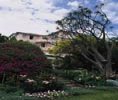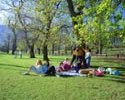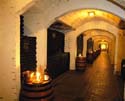Cape Town Wine lands
Don't miss the Wine Region Highlights
Discover
the Cape Town Wine lands highlights. You'll
have the opportunity to combine a drive
along mountain passes, excellent cape
town wine tasting and having lunch in
the finest of restaurants of the Cape
Town wine region. The drive includes Sir
Lowry’s Pass with the magnificent view
over False Bay, Viljoen’s Pass in the
fruit growing area between Villiersdorp
and Grabouw, the Franschhoek Pass with
its splendid view over the Franschhoek
valley and Hell’s Hoogte pass, outside
Stellenbosch. Come and explorer our South
Africa wine region.
CAPE TOWN WINE LANDS TOUR DETAILS
Distance: 247 km / 154 miles
Duration: Full day
Best time: All year
Included: Certified driver/guide, a/c vehicle and gasoline
Excluded: Entrance / tasting fees, lunch, drinks
Price: R1400.00 pp for 2 persons per day, R950.00 pp for 3 persons per day, R750.00 pp 4+ persons per day.
Approximate tasting fees to pay: R 60.00 per adult per wine estate
Note: All tours can be customized
 Inquire
about the Cape Town
Wine lands
Inquire
about the Cape Town
Wine lands
-
Cape Town Wine lands Tour -
 1.
GROOTTE SCHUUR HOSPITAL
1.
GROOTTE SCHUUR HOSPITAL
We drive by the Groote Schuur Hospital
on our way to the Cape Town Wine lands.
Prof Christiaan Barnard transformed the
first human heart transplant in 1967 in
Grootte Schuur Hospital. Prof Barnard
and his team implanted the heart in to
Mr. Louis Washkansky, a Polish dentist.
He lived for 18 days before succumbing
to pneumonia. The operation was considered
as a success.
 2.
RHODES MEMORIAL
2.
RHODES MEMORIAL
Rhodes Memorial, temple-like, was constructed
in 1912 from Table Mountain granite. At
the foot of the monument’s stone steps,
which are guarded by eight massive bronze
lions, stands an impressive equestrian
statue. Magnificent views of the city
and the immediate suburbs below can be
enjoyed. Afternoon tea can be enjoyed
in a charming old stone cottage that serves
as a restaurant.
 3.
TOWNSHIPS
3.
TOWNSHIPS
The first township was built 1900 and
situated next to the old harbour in Cape
Town. The people were removed to Ndabeni
when the bebonic plague broke out during
1918. They were again removed to Langa
in 1923 when the Spanish flu broke out.
Guguletu was built in 1948 and the hostels
were developed to house the black male
migrant workforce. Expansion of the local
townships continued after that.
 4.
SOMERSET WEST
4.
SOMERSET WEST
The quiet flower-filled residential town
of Somerset West lies among vineyards,
orchards and farmlands at the foot of
the Helderberg Mountain. The Helderberg
Nature Reserve on the slope of the Helderberg
is famed for its magnificent proteas,
disas and abundant bird life. The wine
farm Vergelegen, is situated in the corner
of the Helderberg and Hottentot Holland
Mountains and producing fine wine. The
ancient camphor trees on this farm have
been proclaimed national monuments.
 5.
SIR LOWRY’S PASS
5.
SIR LOWRY’S PASS
Sir Lowry’s Pass is also known as “Gantouw”,
the Khoi Khoi word for Eland. The pass
was built and opened in 1830 and named
after Sir Lowry Cole, Governor of the
Cape Colony 1828-1833. Major Charles Mitchell
was instructed to repair the old pass
but he decided to build a proper pass
across the face of the mountain.
 6.
GRABOUW
6.
GRABOUW
Grabouw was built on the farm allocated
to a German- born painter named Wilhelm
Langschmidt in 1856. The town was given
this name because of the birthplace in
Germany (Grabouw) of the owner. Grabouw
is known for the more than half of South
African’s apples that are grown here.
This town is also the commercial centre
for the fruit and timber growing areas
of Elgin and Hottentots Holland.
 7.
HOTTENTOT HOLLAND NATURE RESERVE
7.
HOTTENTOT HOLLAND NATURE RESERVE
The Hottentot Holland Mountains Nature
Reserve covers 42 000 ha and provides
protection to 1 300 species of mountain
fynbos. The reserve stretches from Sir
Lowry’s Pass in the south to the Franschhoek
Pass in the north and from the Stellenbosch
Mountains in the west to the Groenland
Mountains in the east. Several day walks
and overnight trails can be explored.
 8.
VILJOEN’S PASS
8.
VILJOEN’S PASS
Viljoen’s Pass twists and turns through
the mountains between the towns Grabouw
and Elgin through to Villiersdorp. It
was named in honour of Sir Antonie Viljoen,
the man who began the apple industry after
the Anglo Boer War. The original pass
was replaced in the early 1900s by a route
cutting through the Groenland Mountains
along a gorge carved by the Palmiet River.
Lookout points give exquisite views from
the crest over the fruit farms and the
even more spectacular Theewaterskloofdam.
 9.
THEEWATERSKLOOF DAM
9.
THEEWATERSKLOOF DAM
Theewaterskloofdam is built in the 1970s,
it is the largest dam in the Western Cape.
The dam was built to improved the water
of a tangle of rivers including the east-flowing
Riversonderend. The brownish colour of
the water accounts for the name of the
dam (Tea-water –ravine). The dam is a
popular venue for water-sport enthusiasts.
 10.
FRANSCHHOEK PASS
10.
FRANSCHHOEK PASS
The original route over the Franschhoek
Pass Mountains followed the tracks of
the San and migratory game – hence the
original name of Elephant Pass. Building
of the present pass began in 1923 and
was completed in 1925. Viewpoints offer
impressive scenes over the picturesque
Franschhoek Valley. The mountains are
covered with the Cape fynbos and one may
encounters baboons along the way.
 11.
FRANSCHHOEK
11.
FRANSCHHOEK
Franschhoek (in the center of the Cape
Town wine lands) was found 1688 when the
Hugenots were settled here. The town’s
name means “French corner”. As a legacy
of their Hugenot past, many fine estates
and homesteads still bears their original
French names. A graceful, imposing memorial
and museum commemorates the arrival of
early Hugenots. Franschhoek is a pleasant
little town and a culinary mecca to be
explored.
 12.
HELLSHOOGTE PASS
12.
HELLSHOOGTE PASS
Hells Hoogte Pass or literally Hell’s
Heights meaning “Steep Heights”. Hell’s
Hoogte Pass connects Stellenbosch with
the Franschhoek Valley. It was built in
1854 and is a scenic drive through the
Jonkershoek mountains and Simonsberg.
En-route on the Hells’s Hoogte Pass one
experience how the Jonkers Hoek Mountain
changes its shape dramatically from a
different point of view.
 13.
STELLENBOSCH
13.
STELLENBOSCH
Stellenbosch is the second oldest Dutch
settlement in South Africa (in the heart
of the cape town wine lands) and is established
in 1679 by the Dutch governor Simon van
der Stel. The town has the most Cape Dutch
style buildings that is only found in
South Africa. The wineroute of Stellenbosch
was the first to open in 1971 and is also
the largest. Stellenbosch is the heart
of the Winelands and a town enlivened
by its large student population. Stellenbosch
is well served by pubs and taverns and
a very social life by students at the
local university.
 14.
SPIER
14.
SPIER
The wine estate has recently been renovated
and upgraded into a showpiece for the
Cape Town wine lands. Spier offers much
to the visitor. One can relax and spend
the whole day at Spier. A cheetah breeding
project, Eagle encounters and horses for
equestrian and pony rides for children
forms part of the property. Picnic baskets
are for sale to be enjoyed under the lovely
trees around a huge pond. Other attractions
are wine tasting, a wine shop, an open
air amphitheatre that offers live jazz,
classical and light music in summer and
much more.
 15.
ADDITIONAL: CAPE TOWN WINE TASTING
15.
ADDITIONAL: CAPE TOWN WINE TASTING
It was the Dutch who first brought the
vines to the Cape in 1654 and harvested
first grapes in 1658. On 2 February 1659
Jan van Riebeeck produced the first wine
and wrote: “today, praise the Lord, wine
was pressed from the Cape grapes for the
first time” in his diary. The sunny slope,
the cooling ocean breezes, exceptionally
fertile soil, the fact that the coastal
region at the Cape is free from hail and
frost in the fall, create ideal conditions
for growing wine. Wine king Hugh Johnson
declared “Nowhere in the world it is easier
to produce excellent wine than in Cape
Town Wine Lands”.
for
more possibilities Top
14 - Cape Town tour recommendations